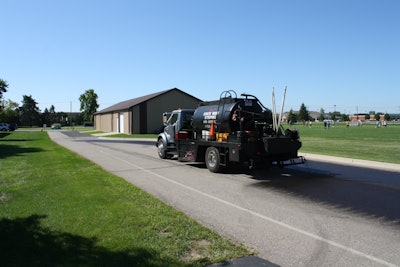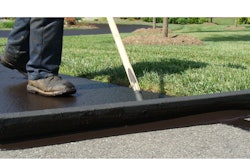
The reason to sealcoat asphalt pavement is to extend the life of the pavement investment. It’s as simple as that.
Whether contractors are sealcoating driveways or parking lots, the original pavement investment by customers is significant. So anything contractors can do to slow the rate of pavement deterioration improves the life cycle costs of that pavement investment. And sealcoating – as part of a comprehensive pavement maintenance program – plays an important role in extending pavement life.
“Sealcoating is essential in pavement preservation and extending the life of your asphalt pavement,” says Greg Houser, vice president of research and development for Neyra Industries. “There are many benefits of sealcoating asphalt, including improving visual aesthetics, resisting oxidation from the sun, replacing eroded surfaces, extending the life and optimizing the overall value of the asphalt pavement.”
“Whether it’s a refined tar sealer or an asphalt-based sealer, you want to put down a layer to slow down the degradation of the hot mix asphalt pavement,” says Rob Vance, vice president of sales and marketing for Vance Brothers and current chairman of the Pavement Coatings Technology Council (PCTC). “Is it going to prevent the deterioration from happening? No. But it will slow down the deterioration.”
Basically, the reasons for sealcoating revolve around the limitations of the asphalt concrete pavement on which it’s used. In his “Basic Sealcoating Principles” session at the 2015 National Pavement Expo, GemSeal’s Lee Lowis explained that asphalt pavement offers poor resistance to ultraviolet radiation and sunlight. He said that exposure to sunlight results in oxidation of the pavement, which results in a loss of pavement “plasticity.” Lowis said oxidation allows the attraction of water molecules, which accelerates thermal and fatigue cracking and surface raveling.
So the reasons to sealcoat are directly related to what sealcoating can do to address each of these issues.
Assuming that most asphalt pavements are designed and constructed correctly – meaning the subgrade is sound and compacted, the appropriate base material is placed and compacted properly, and the correct thickness of hot mix (based on type and volume of traffic) is placed and compacted properly – sealcoating will extend pavement life by protecting the asphalt binder from oxidation, slowing the inevitable deterioration.
“Sealer is only as good as the bituminous pavement to which it is applied,” according to the Neal Mfg. Total Maintenance Handbook. “It will not prevent the cracking of bituminous pavements caused by excessive voids, poor mix stability, poor compaction or low use areas.”
Slowing oxidation
Because asphalt pavement offers poor resistance to UV rays and sunlight, it begins to deteriorate as a result of oxidation – exposure to the air and sun – as soon as it’s constructed.
“Oxidation deteriorates asphalt – the binder in asphalt pavement – quickly,” Vance says. “Oxidation speeds up the aging of asphalt pavement, so anything you can do to slow the oxidation process will extend pavement life,” Vance says. “Sealcoating will slow oxidation.”
Jeff Luzar, division manager of GuardTop, which recently opened an Atlanta branch to market its line of asphalt-based sealers, says that some oxidation is essential; the key is to sealcoat before oxidation goes too far.
“When you put that asphalt pavement down it’s loaded up with oils, and you need some of that oil to oxidize out, which strengthens the pavement. As the oils leave, the asphalt gets harder and harder,” Luzar says. “But if you allow too much of the oils to oxidize out the pavement becomes brittle and more susceptible to cracking. So you need to sealcoat before that happens.”
As oxidation progresses, fines are released from the pavement surface, exposing larger aggregate, and as the pavement continues to dry out and is exposed to traffic (as well as a variety of weather conditions) aggregate can be pulled out of the pavement and small cracks begin to form. These cracks, if left untreated, eventually become larger, providing a way for water to work its way beneath the pavement.
“Once you get even one crack in there you’re going to get water in the subgrade and that water starts creating mini sinkholes,” Luzar says. “As traffic drives over that part of the pavement the soft subgrade makes it easier for the pavement to crack, and pretty soon you have alligatored areas that can only be fixed through remove-and-replace.”
He says sealcoating protects the asphalt surface by slowing oxidation and by filling the hairline cracks that eventually can become entryways for water. It also (because sealer contains fillers and usually sand) replaces some of the fines lost through oxidation and erosion and fills hairline cracks.
“If left unprotected, the asphalt binder, or glue that hold the stone and sand in place, loses strength and the mat becomes brittle, allowing stone and sand to roll out,” Houser says. “The surface will crack, allowing water to get in, creating alligatored areas, potholes and other defects.”
Sealcoating as Part of a System
“Keep in mind it’s a film we’re putting on there. I worry that sometimes people oversell it too much,” Vance says. “It’s a good practice and a smart practice to sealcoat a parking lot, but there are limits to what it can do,” Vance says.
For example, sealcoating doesn’t stop water from coming in. “Water will find a way into the pavement if the pavement hasn’t been built properly. Water always finds the path of least resistance,” Vance says.
Which is why Luzar and Vance say sealcoating needs to be done in conjunction with other pavement maintenance practices, specifically cracksealing and remove-and-replace pavement repairs.
“It needs to be part of a system,” Vance says. “If you have a damaged area or a pothole, that needs to be removed and replaced before sealcoating for sealcoating to be most effective. And cracks need to be filled properly because sealcoating isn’t designed as a crackfiller.”
Improving Pavement Appearance
There’s no question that sealcoating improves the appearance of asphalt pavement, and in fact appearance is one reason many property managers sealcoat their pavement every year or two.
“The parking lot is the welcome mat to your property – to your store or your mall,” Luzar says. “So if you parking lot looks terrible then you don’t present an inviting place and that’s going to affect your store traffic. On the other hand if it’s nice and black with bright stripes – that tells the public that you run a nice operation and you take care of the place they’re going to visit, so you’ll probably take good care of them.”
The Institute of Real Estate Management (IREM) confirms that the subjective idea of “curb appeal,” or how a property looks to the public, is in fact a very real phenomenon. Houser says that on a scale of 10, appearance ranks 8 and the parking lot is a big part of that perception. So one of the simplest things to improve a property and raise its “curb appeal” is to sealcoat the parking lot.
“One of the most important ways to attract and retain tenants in office building or property management settings is to maintain the property's exterior and curb appeal,” Houser says. “The property’s parking lot is the first impression for potential tenants and their customers, so curb appeal is paramount. A clean, well-maintained parking lot indicates a professional outlook in all aspects of business and translates into a positive first impression.”
Refined coal tar sealer is a blacker product that many property managers prefer, but asphalt-based sealers also result in an improved pavement appearance, making striping stand out and improving the curb appeal of property.
“Aesthetically, sealcoating shows off the grass, the stripes and the building making it all look better and more appealing,” Vance says. “We’re a service-oriented society and an ego-centric society and we all like to look good. So anything property owners can do to improve the appearance of their parking lot makes their shopping center or mall or office building that much more appealing to the public.”
“Sealcoating does make a pavement look great and that’s important to a lot of property owners and managers,” Luzar says. “But the main reason for sealcoating is to keep the fines and the aggregate locked into the asphalt so the pavement doesn’t crack. Sealcoating locks the fines and binder and aggregate into the asphalt.”
Which Type of Sealer?
Lowis in his Basic Sealcoating session said that because of its petroleum-based nature, asphalt pavement offers poor resistance to petroleum products, chemicals and salts. He said gasoline and oils dissolve directly into the asphalt and that petroleum products soften the pavement structure. So simply because of its chemical makeup refined tar sealer offers better protection than asphalt-based sealers against gasoline, oil, chemicals and salt.
And Vance says refined tar sealers generally last a year or so longer than asphalt-based sealers. But he says most sealer producers make both type of sealer (in addition to asphalt-refined tar blends) so the decision on which type of sealer to use is often dictated by contractor preference and market demand.
“Whether you use an asphalt-based sealer or a refined tar sealer as long as you’ve done something you’re money ahead,” Vance says.
And Houser agrees. “Sealcoating and other pavement maintenance techniques add value and extend the life of existing pavement, making the use of sealer a cost-effective approach to pavement maintenance.”


















